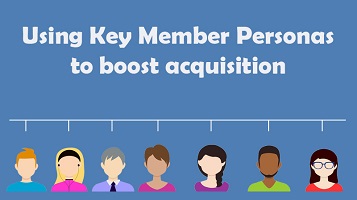How do you decide what content goes into your marketing material? How do you choose what to write in your emails? What’s the inspiration for your blogs?
The best membership bodies don’t just pluck words out of the air. They use personas to help them understand personalities to construct relevant content that engages with individual members.
What is a persona?
A persona is a fictional description of your typical customer, or target customer. By simply choosing a selection of your target group, you can combine important qualities to gain a better understanding of your target group. This enable you to make more informed decisions with your marketing efforts.
By understanding your members’ education, job roles, responsibilities and career drivers, you can start to create meaningful and engaging conversations with them.
How do you construct personas?
With a key member persona, your association can pinpoint who is most likely to become a member and invest in your organisation. Treat it as a more sophisticated target market.
Your association should have member personas to refer to when developing marketing strategies and building advertising materials. However, if you’ve never created one before, you might not know where or how to start.
Here’s your guide on how to create your perfect member persona to drive membership.
Pen and paper at the ready?
Review your data
Once you know your focus (in this case it’s driving membership), use your member data to sketch a rough outline of who your current members are. Typically, this information will be mostly demographics, and this leads onto the next point…
Characteristics are key
The first step of building your persona is to focus on which characteristics your persona is most likely to have.
To do this, use logical analysis and your general knowledge of your current members. Think of this as picturing your perfect member.
What is their gender? How old are they? What’s their line of work? What’s their seniority? Location? These questions will help you identify the traits of your member persona.
Multiple Personas
Most associations bring in a wide variety of members from different backgrounds and locations.
Building multiple personas is great for this, and it’s useful from a sales and marketing perspective to have a segmented audience.
For example, say you have three different personas: Harry, James and Lucy.
Harry could be a young, male student who has just started out in their career. Their focus is professional development and advancing their career. Lucy, on the other hand, is in her 40s and an expert in her field. Her motive for becoming a member is to network and read in-depth articles.
Thirdly, James doesn’t fit into any of these boxes. However, these three people all turn to your association for benefits. It’s your job to pinpoint what stands out about your association for each of these personas.
Dig Deeper
You now know who your members are, and you’ve built a persona based on their demographics and job function. Now you can fill in the details and really get to know your members. How far is Lucy’s commute? Does she have a stressful job? What are her daily struggles?
Does Harry take further training outside of work hours? What does James share on social media?
Personal information will help you connect with your members on a personal level and speak to them in a way that engages them best.
Goals, fears and challenges
As with any career, your persona likely has career goals and challenges.
There are two questions to ask here:
- What does your member want to achieve and how can you help?
- What are they scared of and how can joining your association alleviate these fears?
For example, if Harry fears losing his job, he would join your association to networking and search job opportunities. James, on the other hand, might aspire to become a senior figure in his career and your association provides plenty of guidance.
Member Journeys
Identifying how your association bridges the gaps for your members can be identified with member journeys.
A member journey is a map of the steps a member goes through when interacting with your brand.
One of the benefits of a user journey map is that it encourages you to think like a customer. As you put yourself in the mindset of your members, you can line up their goals and behaviours with your sales funnel. Track the steps that a typical member makes as you go through your touchpoints. For example, do prospective members want to read education content before signing up as a member, or vice versa?
Furthermore, you can identify what your target members are missing (or fear) in their career, and pinpoint how your membership helps them overcome this.
Anything missing?
Even though your member personas are fictional, they’re the best representation you have of the characteristics of your target audience. One you’ve finished building each persona, you should know them like the back of your hand – or should that be their hand?
This will help you understand your members in real life. So, before moving any further, evaluate what information you have and ask if there is anything missing. If you have unanswered questions, go back to your data, or survey your members.
Use your member personas to improve your membership drive
Member personas are not just a creative exercise. The best personas are analytically constructed based on data and conversations with real members. This can provide you with incredible insight into your target demographic.
Your association can use these insights to improve, not just your marketing, but your overall member experience. Your members can go from feeling engaged to your association, to feeling that your association “really understand me.”
 PSP-IT is an award-winning IT service provider who has worked with large membership associations. Our work includes bespoke website development, software application development and Membership CRM development.
PSP-IT is an award-winning IT service provider who has worked with large membership associations. Our work includes bespoke website development, software application development and Membership CRM development.
Speak to our team of experts: 01775 722377.









Leave A Comment